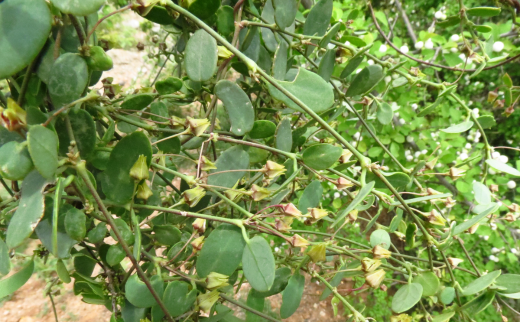Kakanasa/ Small-leaf Milkweed/ Pentatropis capensis – Ayurvedic Uses
Abstract
Pentatropis capensis is traditionally recognised and used by folklore practitioners under the name Kukka Bachchataay. In Ayurveda, it is identified as Kakanasa and is mentioned in classical texts for its therapeutic significance. The Siddha system refers to it as Uppilankodi, where it is used in the preparation of gold and silver parpams (bhasma formulations). Sushruta briefly mentions it in Anuvasana Vasti (medicated oil enema), while Ashtanga Hridaya describes its use in treating Guhya Roga (genital disorders), as well as in Chyavanprash and Anuvasana Vasti Karma. Various Ayurvedic lexicons highlight its properties as an emetic, rasayana (rejuvenator), balya (strength promoter), palitapaha (anti-greying), analgesic, and anti-inflammatory. It is considered beneficial in managing Shotha (inflammation), Raktavikara (blood disorders), Shvitra (vitiligo), Kustha (skin diseases), and Gulma (abdominal tumours).

Introduction
Pentatropis capensis (L.f.) Bullock, belonging to the family Apocynaceae, is a twining climber of high ethnomedicinal significance, particularly in Ayurvedic and Siddha systems of medicine. It is traditionally known as Kakanasa in Ayurveda and Uppilankodi in Siddha. It has been used in the management of various conditions, including headaches, skin disorders, respiratory congestion, and fever. Acharya Charaka mentioned Kakanasa in the Madhura Skandha of Vimana Sthana (8), highlighting its nourishing qualities. It is included as an ingredient in classical formulations such as Chyavanprasha, Trayaushanadi Ghrita, and therapies for conditions like Apasmara (epilepsy), Yoni Roga (gynaecological disorders), Kasa (cough), Kustha (skin diseases), and in Anuvasana Basti procedures.
It is native to the Indian subcontinent, especially in arid and semi-arid regions. This plant is frequently found growing in wastelands, rocky slopes, and dry forests. Phytochemical investigations reveal the presence of triterpenoids, flavonoids, β-sitosterol and salicylic acid, which contribute to its analgesic, anti-inflammatory, and antimicrobial properties. Classical literature and tribal practices recognise its utility in formulations involving bhasma, and emerging pharmacological studies support its therapeutic potential, paving the way for further clinical exploration.
Scientific Classification
- Kingdom: Plantae
- Order: Gentianales
- Family: Apocynaceae (Previously: Asclepiadaceae)
- Genus: Pentatropis
- Species: Pentatropis capensis
Synonyms
- Kakanasa
- Kakangi
- Kakatundphala
Vernacular Names
- Hindi: Kukka Bachchataay
- Sanskrit: Kākanāsā
- Tamil: Uppilankodi
- Kannada: Kaadu Soppu
- Telugu: Kukka Tegada
- Malayalam: Kurumulaku Valli
Habitat
Pentatropis capensis (L.f.) Bullock is widely distributed across the Indian subcontinent and adjoining regions. In India, it is predominantly found in the dry deciduous and scrub forest zones of Rajasthan, Gujarat, Maharashtra, Delhi, and West Bengal, and also extends into Pakistan and Sri Lanka. The species prefers arid and semi-arid climates and grows well in dry, rocky soils, wastelands, hedgerows, and roadside thickets. It is a xerophytic climber that thrives in full sunlight and is frequently observed climbing over shrubs, fences, and low trees.
Morphology
Pentatropis capensis is a slender, twining climber that exudes a characteristic milky latex, typical of the Apocynaceae family. The leaves are opposite, ovate to elliptic, measuring 1–3.5 cm in length and 0.5–2.5 cm in width. Leaf tips are mucronate or blunt, attached by petioles 4–7 mm long. Flowers are greenish-purple to brownish, borne in axillary cymes. Fruits are paired follicles (3.7–6.8 cm long) containing comose seeds that aid wind dispersal. Flowering occurs from October to December.
Classical Categorisation
- According to Charaka: Madhura Skandha
- According to Bhavprakash Nighantu: Guduchyadi Varga
Ancient Verses
काकनासा कषायोष्णा कटुका रसपाकयोः ।
कफघ्नी वामनी तिक्ता शोथार्शश्वित्रकुष्ठहृत् ॥
(Bhavprakash Nighantu Guduchyadi Varga 170)
According to this verse, Kakanasa has astringent, pungent, and bitter taste, hot potency, and balances Kapha dosha. Its post-digestion effect is pungent. It is effective in inflammation, piles, and vitiligo, and also induces vomiting.
Ayurvedic Properties
- Taste (Rasa): Bitter (Tikta), Pungent (Katu), Astringent (Kashaya)
- Physical property (Guna): Light (Laghu)
- Potency (Veerya): Hot (Usna)
- Post-digestion effect (Vipaka): Pungent (Katu)
- Effect on Tridosha: Balances Kapha dosha
Therapeutic Properties
- Anti-inflammatory
- Hemorrhoids
- Vitiligo
- Analgesic
- Antiseptic
- Antifungal
Chemical Composition
- Aliphatic Alcohols: n-Octacosanol
- Triterpenes: α-Amyrin, Friedelin
- Phytosterols: β-Sitosterol
- Phenolic Compounds: Salicylic acid, Flavonoids, Other phenolics
- Others: Tocopherols (Vitamin E compounds), Terpenoids
Modern Overview
Anti-inflammatory Activity
The anti-inflammatory activity of Pentatropis capensis is primarily attributed to flavonoids, triterpenoids, β-sitosterol, and salicylic acid. Flavonoids inhibit key inflammatory enzymes like cyclooxygenase and lipoxygenase while neutralising free radicals. Triterpenoids such as α-amyrin and friedelin suppress pro-inflammatory cytokines and block NF-κB signalling. β-Sitosterol modulates immune responses and stabilises cell membranes, while salicylic acid inhibits prostaglandin synthesis, similar to NSAIDs. Together, these compounds exert strong anti-inflammatory effects.
Practical Uses
- Warmed leaf juice is used as nasal drops for headaches, runny nose, and body aches.
- Leaves boiled with coconut oil are applied externally to cuts, wounds, and skin diseases.
- Leaves are consumed by tribal communities for general health.
- Whole plant decoctions are given to children as anthelmintics.
- Fruit paste is applied in scorpion bites.
- Leaf paste is used to manage indigestion.
- Flower and leaf paste helps stop bleeding.
Part Used
Whole plant
Special Note
Some plants have been considered substitutes for Kakanasa. Pentatropis microphylla W. & A. is often regarded as Kakanasa. Trichosanthes cucumerina Linn. fruits, eaten by crows, were mistaken as Kakanasa. Thunbergia alata Boj. (due to fruit resemblance) and Brihati (Solanum indicum Linn.) have also been identified as possible alternatives.
Conclusion
Pentatropis capensis is a valuable medicinal plant traditionally used in Ayurveda and Siddha for a wide range of ailments. It exhibits anti-inflammatory, analgesic, and antimicrobial properties, attributed to bioactive compounds such as flavonoids, glycosides, tannins, and steroids. Used both internally and externally, it treats respiratory issues, skin diseases, wounds, and inflammation. However, further scientific and clinical validation is essential to ensure its safe and effective use in modern medicine.



